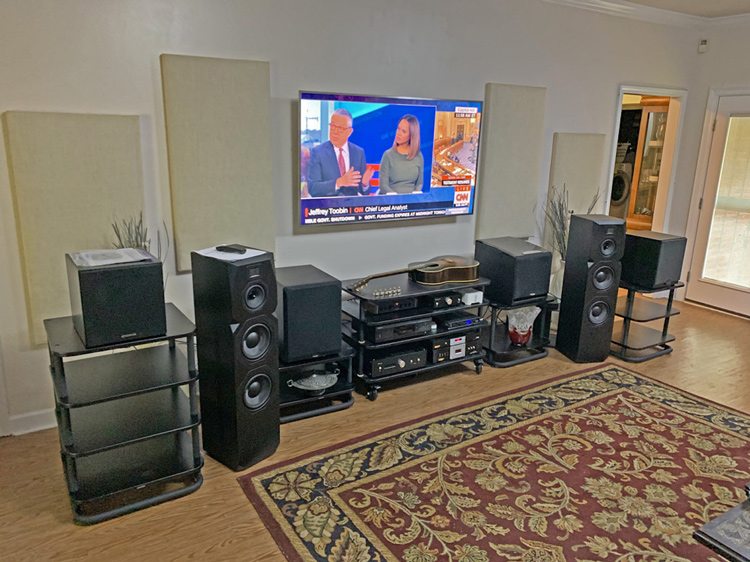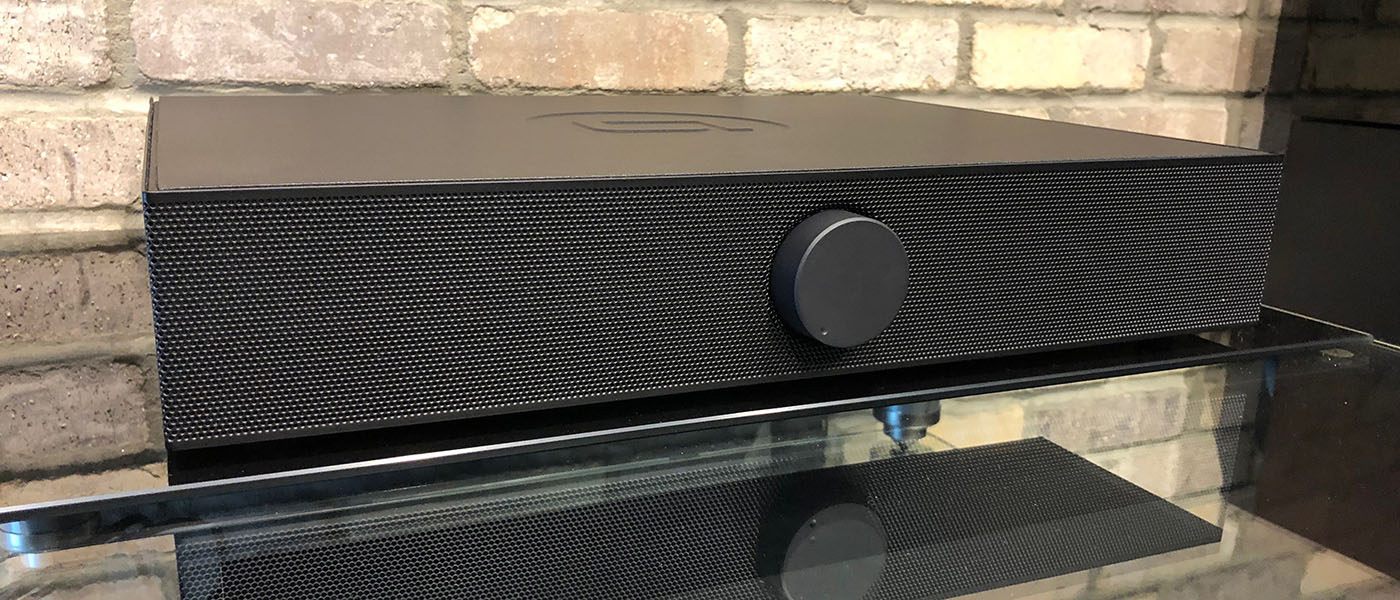
Many are familiar with the computer concept of a “redundant array of inexpensive disc-drives,” commonly called “RAID.” I decided to try my own concept of the “redundant array of inexpensive subwoofers (RAIS).”
The emphatic part of the acronym, of course, is the “inexpensive.” And so, I began to collect subwoofers at random including:
Emotiva X-Ref 10 ($150 from a friend)
Velodyne DPS-10 ($50 from a yard sale)
Paradigm DSP-3200 Ver. II ($45 from an estate sale)
Martin-Logan Dynamo 500 ($220 new on a clearance sale)
So the total cost of the four mismatched subs was $465 – the approximate cost of a single fairly “medium-quality” new subwoofer.
The advantages of multiple subwoofers include:
- Diffusion of room nodes
- Lower distortion for the same sound pressure level (SPL) since each cone has to move less
- Avoidance of clipping any of the subwoofer amplifiers (since each sub has to produce less volume)
- Convenience and variety of placement (each individual subwoofer’s placement becomes less critical)
The balancing of the four subs was slightly more involved, but with either an SPL app on your cell phone or a calibrated microphone and Room Equalization Wizard (REW) software it’s fairly easy to do. And before criticism is unleashed about the use of a cell phone as an SPL meter, allow me to point out that ultimate accuracy IS NOT IMPORTANT. Instead, the consistency of measurements is. In other words, if your cell phone is 15 dB off at 80 Hz. it will be consistently 15 dB off with all subsequent 80 Hz. measurements. Therefore, it isn’t important to use a highly accurate means of volume measurement – only a highly consistent one.
Secrets Sponsor
Note that the 80 Hz. crossover frequency has been arbitrarily selected for this example. The majority of subwoofers are used with crossover frequencies anywhere from 40 Hz. to 100 Hz.
So to balance my four mismatched subs with my main speakers:
- I turned all four subwoofers off
- I set the main speakers to “full range”
- and played an 80 Hz. tone
- I adjusted the main volume to provide a repeatable level (for my room, I chose 85 dB arbitrarily, measuring from the listening position)
I then went to the website Tontechnik-Rechner Total Level Adding of Coherent Signals. Scrolling down the page slightly brings one to the “Level Addition of Several Coherent Signals” calculator. Fortuitously, one can total up to four signal-sources to see what SPL they produce simultaneously.
By using their calculator (the formula is included if you want to “roll your own”), I determined that each subwoofer would need to produce 73 dB at the same listening position that the main speakers were measured from. The combined output of the four subwoofers should then sum to 85 dB (matching the main speakers). Keep in mind that the summation of sound pressure levels is a logarithmic rather than a linear function. This is what accounts for the numerical discrepancy vs. simple addition.
To measure each individual subwoofer:
- I turned the main loudspeakers off
- I turned three of the four subwoofers off
- I turned off the subwoofer plate-amp crossovers (by setting their crossover frequencies as high as possible on each subwoofer)
- I set the subwoofer crossover frequency on the AVR as LOW as possible (at least one octave below the desired test tone frequency – This means that if I want to measure at 80 Hz., the crossover frequency in the AVR should be set to 40 Hz. or lower (80 ÷ 2). This ensures that the AVR will not roll off before the frequency you want to measure.
- I played the same 80 Hz. tone at the same main volume setting (this is important – the main AVR’s volume setting must be identical to the setting that produced the reference volume when playing the main speakers)
- I then used the volume control on the subwoofer’s plate amplifier (not the AVR volume control) to provide a measured 73 dB at the listening position
- Once the first subwoofer was set to 73 dB, I turned it off and then repeated the steps for each other individual subwoofer (one sub at a time)
- Note that due to amplifier power differences, driver sensitivity, and distance from the listening position every subwoofer ended up with a slightly different gain setting on its own plate amplifier
When finished, I turned on the four subwoofers simultaneously and measured exactly 85 dB at the listening position.
After the level setting is completed, the AVR’s crossover point may be restored to your preferred frequency. To ensure the best match, the test tone should have been the same frequency that you normally use as your crossover setpoint (80 Hz. is typical). Note that the crossovers on the subwoofers’ plate amplifiers are either turned off or left at their maximum crossover frequency. All main, center, and surround speakers in the system should be set to “small.” This routes all bass (including the movie low-frequency-effects channel) to the subwoofers.
And although it isn’t pertinent, specifically, to the idea of using multiple subwoofers, let’s also discuss briefly the choice of crossover points for stereo music listening. This discussion will deliberately ignore the use of subwoofers for movie soundtrack purposes.
Secrets Sponsor
Some prefer to use their main loudspeakers “full range” and then use subwoofer(s) to “fill in” the frequencies that the main speakers can’t reproduce. I contend that this is not the best use of your subwoofers. This choice throws away the main benefits of using subwoofers in the first place. Those benefits include:
- Relieving the main power amplifiers of having to reproduce low frequencies
- Reducing cone excursion on the main speakers (mainly caused by low frequencies)
- Reducing intermodulation distortion in the main speakers (mainly caused by high cone excursion)
- Allowing the main speakers to be located for the best imaging rather than best bass
Instead, I recommend setting the subwoofer crossover point as high as feasible, up to about 100 Hz., where directional clues might allow your ears to identify the specific subwoofer locations. With a truly full-range set of main speakers, the crossover might be set as low as 40 Hz. and with bookshelf speakers, as high as 100 Hz. Experiment to determine the best frequency for your main speakers. And now back to the discussion of RAIS:
The skeptical will complain that each individual subwoofer has a different frequency response, a different -3dB low-end extension, and a different damping factor. And the skeptics are entirely right. But in practice, the mismatched subs blended smoothly and produced very quick, very tight, and very percussive bass that also exhibited excellent pitch definition.
Note that I did NOT use the subs’ plate amplifiers for crossover separation – I performed that at the upstream AVR or stereo electronic crossover. At the time of this experiment, I also had in the house a most excellent JL Audio CR-1 crossover that I used to create stereo bass with individual right and left channels (two subwoofers per channel). If anything, the two-channel bass sounded even better than the monophonic bass channel from the AVR.
If you own neither an AVR nor a stereo electronic crossover, the Harrison Labs company makes some “FMOD” inline passive filters that can be used in the interconnect path between the preamplifier and the power amplifier(s). These filters come in “high-pass” (for the main speakers) and “low-pass” for the subwoofers and are available in a variety of frequency settings. The filters are second-order, 12-dB per octave filters and the polarity of the subwoofers should be set to 180-degrees out of phase with the main speakers to maximize crossover smoothness. If you aren’t sure of this setting, then listen to music with your subwoofers set to zero degrees phase and then at 180-degrees phase (most subwoofers offer this switch or rotary pot on their plate amplifiers). Whichever setting provides the most bass is the correct one.
So that’s it. Excellent bass can be had using the RAIS concept with inexpensive mismatched subwoofers. Although the overall sound quality of the RAIS is theoretically limited by the worst single subwoofer in the array, I found that faults were mostly inaudible. The four subwoofers blended into a sound quality far greater than the sum of the parts.
So you’ll no longer have to envy your friends mega-buck subwoofers. You can probably equal or exceed their performance with your own affordable RAIS!


